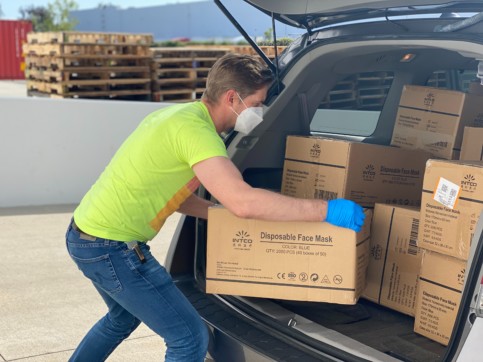5 Rules for Keeping Volunteers Safe in a Pandemic

Mindful community organizations like yours have followed the recommended safety guidelines for months now. But as communities continue to rely on volunteers to deliver vital services, it’s important to remain vigilant.
So, we enlisted the help of a public health expert to bring you these rules for keeping your volunteers healthy while continuing to ensure the wellbeing of your community.
1. Understand the Risk
Before you welcome volunteers back, know the risk volunteer activities pose to you, fellow staff, community members, and volunteers. The more people an individual interacts with, and the longer this interaction lasts, the higher the risk of COVID-19 spread.
Learn the risk level for each type of gathering or activity based on CDC research:
Lowest Risk
Meetings and other activities conducted virtually carry the lowest risk. Essential activities (like the provision of essential services) still occur in person, but essential workers and volunteers wear masks, appropriate PPE, and maintain social distancing when possible.
More Risk
Small, in-person gatherings carry some risk. Here are some ways to reduce risk:
- Prioritize outdoor activities and gatherings.
- Individuals from different households should remain 6 feet apart.
- No food is served.
- Attendees must wear masks.
- Vigorous cleaning and sanitizing practices are implemented.
- Attendees and volunteers should come from the same geographic location (community, town, city, or county).
Higher Risk
Indoor activities and medium-sized gatherings carry higher risks. A higher-risk gathering may encompass the following conditions:
- Activities are held indoors.
- Attendees wear masks and remain at least 6 feet apart.
- Food is served in pre-packaged boxes and disposable utensils.
- Organizers eliminate the need for shared items and serving tables where people congregate.
- A limited number of attendees travel from outside geographical areas.
Highest Risk:
Resuming normal (pre-pandemic) activities carries the highest risk. Highest-risk gatherings may have these conditions:
- Large in-person gatherings are held indoors without masks or distancing protocols in place.
- It’s difficult for individuals to remain 6 feet apart.
- Food is served openly from shared serving dishes and communal tables.
- Many attendees travel from outside the geographical area.
2. Practice Virus Control Basics
Ready to recruit volunteers for in-person opportunities once again? Ensure you have these virus control basics in place first.
Generally, organizations with in-person volunteering should adopt these universal precautions for virus control and prevention:
- Invest in hand sanitizer stations.
- Require volunteers and staff to wear masks. Organizations should provide appropriate personal protective equipment.
- Disinfect frequently touched surfaces.
- Limit attendance.
- Post signage.
People should avoid volunteering with others for 14 days if they have:
- Been exposed to COVID-19 by an individual or community
- Attended a high-risk gathering
- Traveled by cruise or airplane
Additionally, organizations should continue to follow guidelines distributed by the CDC, as well as recommendations made by trusted local officials.
3. Go Contact-Free
The CDC recommends that organizations “consider limiting the sharing of frequently touched objects,” including pens, touchscreens, and paper documents.
Consider these contact-free options to replace processes that normally require frequently touched objects (no communal pens and clipboards needed here!):
- Registration: Encourage volunteers to view and sign-up for volunteer opportunities online from home!
- Check-In: Invite volunteers to check-in to their volunteer shift online using their own mobile devices to limit person-to-person contact.
- Online Documents: Upload documents like waivers and training materials online so that volunteers can read, sign electronically, and return to reduce a physical exchange of materials.
Of course, you’ll want to ensure you have the right tools in place for contact-free volunteer management, so give the technology a test before you welcome volunteers in-person.
4. Adopt Smart Scheduling
Even today, many organizations welcoming volunteers to their facilities must take steps to reduce person-to-person contact and allow for safe distancing. Check with local regulations to set a maximum capacity for each volunteering location. Bare in mind that you may have to reduce the number of volunteers you typically welcome per shift.
People tend to congregate when arriving at their volunteer shift. Consider staggering volunteer arrival times and shifts to reduce natural “grouping.” Create intervals for break times to avoid gathering at snack tables and water stations.
A volunteer management system can allow you to cap registration for volunteer shifts and automatically inform volunteers if the shift reaches capacity. You can also create a waitlist for those who want to participate if spots open up. The right system can also recommend other opportunities according to the volunteer’s interests, so you don’t have to fully turn away eager helpers.
5. Keep Staff and Volunteer Training Updated
As you learn more about the pandemic, be sure to keep fellow volunteers and staff on par. Regular staff and volunteer training sessions are a great way to check in and take stock of the current procedures.
Staff training should include the following topics:
- How to safely check-in volunteers
- How to conduct specific work per CDC guidelines
- How to operate newly implemented technology and online tools
- How to identify possible symptoms of illness
- How to protect vulnerable populations
If any of these procedures change along the way, update staff promptly.
In addition to educating staff on new procedures, provide your volunteers with guidelines for safely carrying out their work. This information can be integrated into your existing volunteer training program.
Volunteer guidelines should include handwashing procedures, PPE requirements, and directions for safe contact with other community members (like how to serve meals safely). This exchange of information will help volunteers feel empowered to conduct their work safely.
Virtual volunteering is your safest option, but your organization may still rely on in-person volunteers to carry out essential services, from delivering meals to distributing school supplies. Follow these rules, stay informed, and you’re more likely to reduce risk and keep each other healthy.
